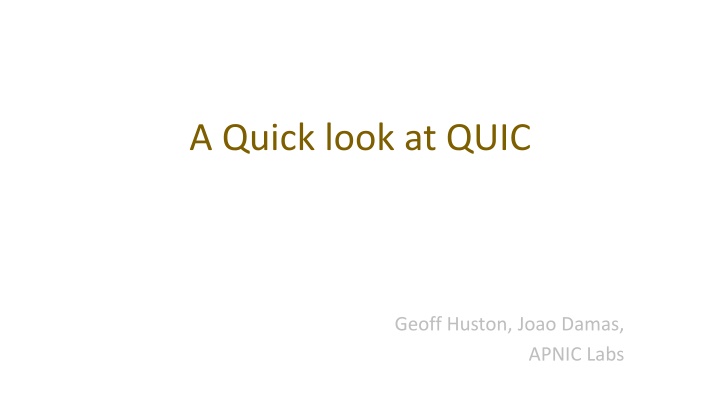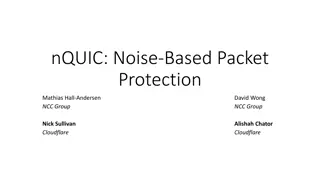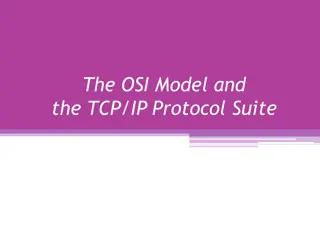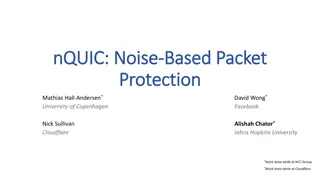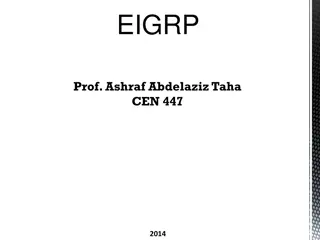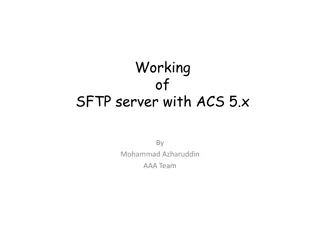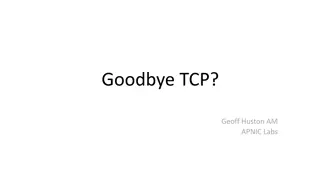An In-Depth Look at QUIC Protocol
QUIC, developed by Geoff Huston, Joao Damas, and APNIC Labs, is a modern transport-level protocol that enhances network service capabilities by leveraging UDP for data transmission. It incorporates features like HTTP/3, encryption, session control, and congestion control while minimizing network exposure. This summary covers the use, deployment, and setup of QUIC servers, along with insights into its adoption trends among users in recent months.
Download Presentation

Please find below an Image/Link to download the presentation.
The content on the website is provided AS IS for your information and personal use only. It may not be sold, licensed, or shared on other websites without obtaining consent from the author.If you encounter any issues during the download, it is possible that the publisher has removed the file from their server.
You are allowed to download the files provided on this website for personal or commercial use, subject to the condition that they are used lawfully. All files are the property of their respective owners.
The content on the website is provided AS IS for your information and personal use only. It may not be sold, licensed, or shared on other websites without obtaining consent from the author.
E N D
Presentation Transcript
A Quick look at QUIC Geoff Huston, Joao Damas, APNIC Labs
QUIC is HTTP/3 HTTP/2 HTTP HTTP Multistream QUIC TLS Multistream Encryption Data stream integrity Congestion Control Session Encryption TCP Data stream integrity Congestion Control UDP IP
QUIC is A transport level framing protocol that offers applications access to the basic IP datagram services offered by IP through the use of UDP All other transport services (data integrity, session control, congestion control) are shifted to the application QUIC also places the transport control fields inside the encryption envelope, so QUIC has minimal exposure to the network
Looking for QUIC At APNIC we use Ads to perform large scale measurements of network service capabilities as seen by users IPv6 deployment DNSSEC validation Fragmentation Can we use this measurement platform to see the level of use of QUIC in today s network?
Setting up QUIC Server: nginx v1.21.7 with QUIC functions included DNS: Set up an HTTPS record for each URL with value: alpn= h3 Content: Alt-Svc: h3= :443 (This second method requires a subsequent query to allow the client to use the Alt-Svc capability. We perform a 2-second delayed second query for this URL in the measurement experiment approximately one fifth of the time. We keep the domain name constant and vary the URL args to detect the second fetch.)
Setting up QUIC Server: nginx v1.21.7 with QUIC functions included DNS: Set up an HTTPS record for each URL with value: alpn= h3 Content: Alt-Svc: h3= :443 First Fetch Second Fetch
QUIC Use June/July 2022 About 3.5% of users use HTTP/3 for the second fetch About 1% of users are seen to use HTTP/3 on first fetch
Some Questions: 1. Which clients are performing QUIC and why? 2. What are the QUIC MSS values? 3. What is the QUIC connection failure rate? 4. Is QUIC faster than HTTP/2 + TLS?
1. OS Clients* performing QUIC TCP/TLS QUIC on First Fetch QUIC on Second Fetch 5.5% 93.3% 1.0% 2.8% 84.5% 1.7% Win 5.5% 1.4% Linux 0.4% 0.2% 0.2% Others 3.1% 0.6% 100.0% 100.0% iOS Mac OS Android 16.1% 0.6% 77.9% 4.3% 0.9% 100.0% * Based on reported browser string
1. Browser Clients* performing QUIC TCP/TLS QUIC on First Fetch Chrome 91.8% Safari 4.3% Firefox 0.8% Edge 0.7% Opera 0.2% Others 2.2% 0.1% 100.0% 100.0% QUIC on Second Fetch 81.7% 16.1% 1.0% 0.5% 0.6% 0.1% 100.0% 4.1% 93.3% 2.4% 0.0% 0.1% * Based on reported browser string
1. Who does QUIC and why? Apple Safari clients use a DNS HTTPS query and some of these clients then follow up with a fetch over QUIC. The observed DNS HTTPS query to QUIC fetch conversion rate was relatively small. Chrome clients use the Alt-Svc field as a QUIC trigger for some clients. Again, the observed QUIC conversion rate was observed to be relatively small * Based on reported browser string
2. QUIC Packet Size distribution Maximum Packet Sizes used in QUIC sessions: QUIC clients take a very conservative approach to maximum packet sizes to avoid packet fragmentation complications 1,200 octets 46.6% 1,250 octets 18.5% 1,252 octets 16.4%
3. QUIC Connection Loss In this measurement framework we cannot measure client -> server loss, but we can measure server-> client loss by looking for incomplete QUIC initial connections that do not complete (this form of connection loss could be due to the client filtering incoming UDP port 443 packets) Initial QUIC Connections: Failed Connections: Failure Rate: 19,211,357 46,645 0.24%
4. Is QUIC Faster? Let s compare the user-measured time to load an object using HTTP/2 and the same user s measured time to load the same object using HTTP/3 There are a number of variables in the user time measurement, including varying time penalties relating to the internal task scheduling within the browser, but these individual factors should be cancelled out over a large enough sample set
4. TCP/TLS vs QUIC speed difference Area where QUIC is faster ms Non-QUIC Faster QUIC Faster
4. Cumulative Distribution HTTP/3 is faster to perform object retrieval in 2/3 of the observed cases ms Non-QUIC Faster QUIC Faster
Some Answers: 1. Which clients are performing QUIC? The recent change appears to relate predominately to iOS 15.x clients (iPhones and iPads) using HTTPS queries and selectively performing an object retrieval over HTTP/3 at a rate of approximately 1 in 5 2. What are the QUIC MSS values? Most QUIC clients limit their total IP packet size to a max of either 1,250 or 1,252 octets. Largest observed packet was 1,357 octets 3. What is the QUIC connection failure rate? Extremely small at 0.24%. This falls within the bounds of experimental error in this experiment s framework. 4. Is QUIC faster than HTTP/2 + TLS? Yes, more than 2/3 of the time QUIC will complete in less elapsed time than the equivalent HTTP/2 retrieval
Observations These QUIC use numbers are far lower than other published measures
Why so low? QUIC is enabled by default in Chrome, so we might expect to see 90% of all connections using QUIC on the second and subsequent fetches. Cloudflare s numbers are based on fetches from their stores, and its unclear which are first fetches and which are repeat fetches from their summary data. The APNIC numbers are based on scripted behaviours of individual clients enrolled via online ads, and the Chrome behaviour is triggered by a scripted repeat fetch following a 2 second timer.
More Questions Why is the HTTPS DNS query rate 3x to 4x higher than the Safari QUIC fetch rate? Surely a HTTP/3 aware browser would try using QUIC if the DNS response indicated that the service was HTTP/3 capable Is a 2 second scripted wait for Chrome too fast in practice? How long does it take for content directives to be stashed in the browser to direct future actions? Does Chrome have the same defaults everywhere? Or are there localized settings in India and China (for example) that disable QUIC by default? Does Safari have the same defaults everywhere?
Thanks! Ongoing HTTP/3 Measurement Report at APNIC Labs: https://stats.labs.apnic.net/QUIC
